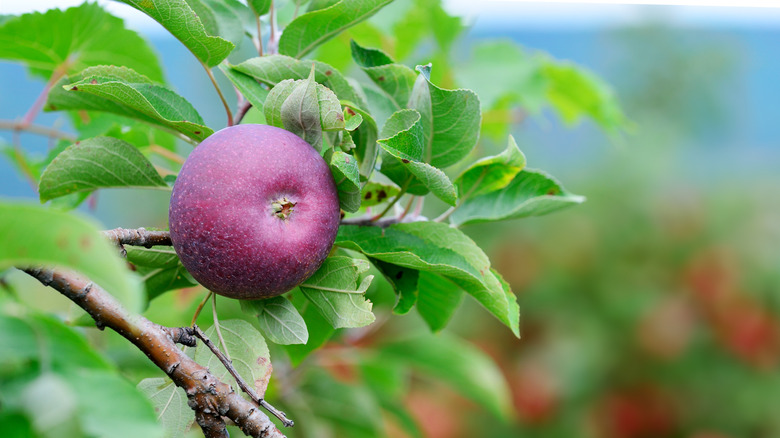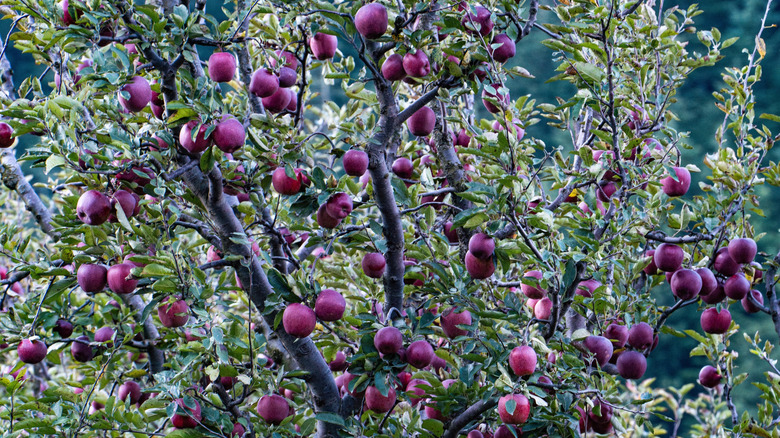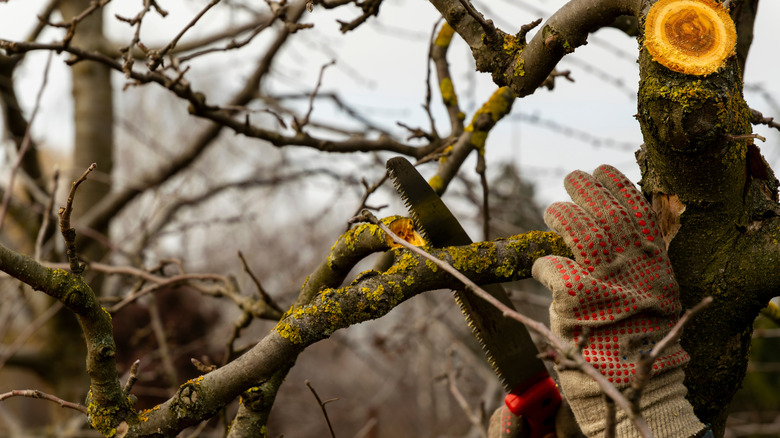The Heirloom Fruit Tree You Can Grow For A Unique Apple Variety
Growing heirloom apple trees is becoming increasingly popular among home gardeners. With their hardy parentage, heirlooms are resilient and fairly easy to grow. There are dwarf and semi-dwarf cultivars that fit into smaller spaces, making maintenance and harvesting easier. With more heirloom varieties becoming available via mail order sources like Fedco, St. Lawrence Nurseries, and Trees of Antiquity, growers can explore a wide world of delicious and interesting apples. One unique heirloom apple variety to try is the Black Oxford, which has recently become a very sought-after heirloom to grow.
Long before I became a professional gardener and orchardist, I tasted these delicious apples straight from the tree. It was in a small orchard, with each tree a different heirloom variety, high on a hill in the Finger Lakes region of New York. The Black Oxford stood out. It was late autumn, and it was the only tree still covered in fruit: somewhat small, very round apples of an extraordinary dark wine red color.
This apple is believed to be a cross between a Hunt Russet and a Blue Pearmain, and was first discovered by a farmer in Oxford County, Maine, in 1790. Records show the same tree was still standing in 1907. Black Oxford apples are dark and sweet, with good winter storage qualities, staying firm and crunchy well into spring. It's considered an excellent all-purpose apple for fresh eating, cooking (leaving the skins on makes pink applesauce), baking, and making cider. Fedco says it is nearly their most popular tree, second only to Honeycrisp.
Which heirloom apple trees to grow with Black Oxford
The Black Oxford apple tree is somewhat unusual in that it blossoms in mid-spring yet has a very late harvest season (starting in mid-November). So growing one of these trees extends the apple harvest season and adds beauty to the late-season garden and orchard. If you're considering growing this tree as part of a mixed micro-orchard, planting it with an array of earlier-ripening apples is a good strategy. There are many heirloom apples that ripen in late August and plenty that ripen in September and October, but you will need to make sure that whatever trees you choose are also suitable pollinators.
Heirloom apple trees almost always need at least one pollinator tree to set fruit. Choose a pollinator tree of a different variety that blooms around the same time; for Black Oxford, this is midseason. The timing of blooms may vary a bit based on your location and local weather conditions (unseasonably warm temperatures can sometimes cause earlier blossoms), but midseason is generally considered to be from late April through mid-May.
There are plenty of midseason blooming heirlooms to choose from whose apples ripen for picking earlier than Black Oxford. Some that I'd recommend include Summer Rose (ripens in July), Rhode Island Greening (ripens in late September), Summer Rambo (ripens in early August), Maiden Blush (ripens in mid-August), or one of my very favorite heirloom apples, Belle de Boskoop, which ripens in early October. Generally speaking, the later an apple's ripening season, the better its shelf life and winter storage capabilities.
How to grow Black Oxford apple trees
The Black Oxford apple (also sometimes called Oxford Black) is one of Maine's most well-known apples, and it's well-suited to the cold winters there, being cold hardy to USDA Zone 3. Like many heirloom apple varieties, this one is resistant to many common diseases, including apple scab, cedar-apple rust, and fireblight. It also has good resistance to common apple tree pests, but always watch for signs of an insect infestation. The Black Oxford's cold, hardy nature and resistance to disease make it a very long-lived tree: a standard-size cultivar may live up to a hundred years or more.
As with any apple tree, make sure to give it plenty of sun and enough space for its canopy not to be crowded. Cummins Nursery sells the Black Oxford Apple Dwarf Cultivar with an eight-foot canopy spread, making it a good size for a smaller space. Semi-dwarf cultivars grow up to 17 feet tall. This tree is known for producing spurs (meaning it can produce fruit along larger limbs and not just on smaller branch tips) and will benefit from regular pruning, so be sure to brush up on how to prune apple trees.
To keep your heirloom apple trees looking good, prune them lightly in spring (only branches smaller in diameter than a pencil) and prune larger branches in late autumn. Since the Black Oxford bears fruit so late, wait to prune it until at least early December, when it has begun its winter dormancy. Also, try to avoid allowing grass to grow next to the base of the trunk, as this can force the tree to compete for moisture and nutrients.


